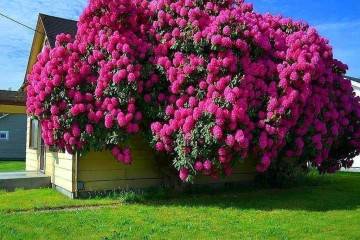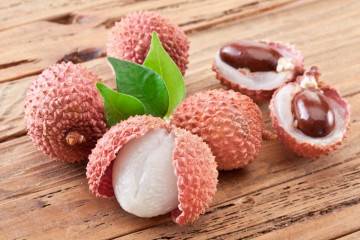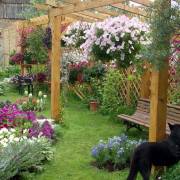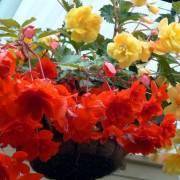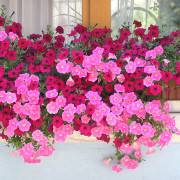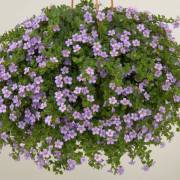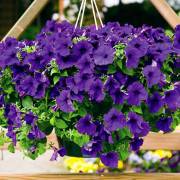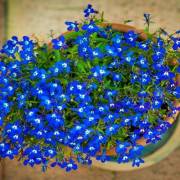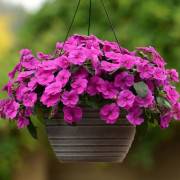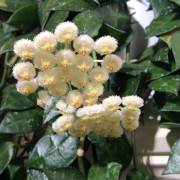What are ampelous plants and ampelous annual flowers
Content:
Ampel plants, or ampels (derived from the German word die Ampel - hanging flower vase) are decorative crops grown in hanging pots, pots. It is very easy to figure out what ampelous means: such flowers have long, flexible stems that need support to grow in a given direction, or go down in the form of a waterfall. In semi-ample flowers, the shoots first stretch up, forming a massive cap, and then begin to bend and hang down.
Features and benefits of ampelous plants
A characteristic feature of plants is a flexible stem that needs support: the flower winds upwards along special nets or stands. In the absence of support for the shoots, the pots are installed or suspended at the required height.
Some plants are used as a ground cover crop, planted in open ground. However, this method does not reveal their true beauty.
The use of this plant species is not limited. They are grown:
- as home decoration or on balconies;
- to create comfort in summer cottages, hanging out pots near verandas, gazebos;
- in greenhouses, botanical gardens;
- for the improvement of public places (parks, squares, stations).
The advantages of growing ampelous plants:
- Mobility. The question of changing the location of the flower is solved instantly: just move the pot to the right place.
- A variety of varieties for creating picturesque compositions.
- Saving space. Flowers do not need to look for free space on the windowsill, shelf. When suspended, they will take up space, like a wall painting.
- Easy maintenance in the form of regular watering and good lighting.
- Rapid growth and flowering throughout the warm season.
- Growing in an urban setting. The lack of a summer cottage is not a reason to abandon gardening: plants can be grown in pots on the balcony, giving it an extraordinary look.
Types of ampelous plants
Among the variety of varieties, there are three groups of ampelous plants.
Succulents
These include Rowley's wildflower, sedum, whip-like dysocactus, etc. These plants are valued for their endurance and minimal care. Succulent shoots hanging from the pot are a weighty mass, so the flowerpot should be very stable or firmly fixed.
Blooming
Representatives of this variety: fuchsia, aimenez, violet, etc. These are lovers of bright lighting, but not direct sunlight, heat, high humidity and regular watering.
Decorative deciduous
These include tradescantia, begonia, crested chlorophytum, and others. Shade-loving plants. For a bright color of the leaves, they need a fertile soil. Watering is carried out only after the soil is completely dry.
What plants are suitable for ampel cultivation
For ampelous cultivation, colorful, beautifully blooming plants with a large cap or long shoots falling from the pots are ideal.
Among succulents, the most popular are:
- Sedum Morgana, or sedum. Growing is possible at home, in the garden. Fleshy cone-shaped leaves form massive whips. Moisture accumulates inside the shoots, and therefore it tolerates drought well. Such a thrifty flower is suitable for busy people who are away from home for a long time. It blooms with small reddish flowers.
- Rowley's godson. People call it a green pearl for its bead leaves strung on a thread - a thin stem. Florists grow a rose flower both at home and in the open field. Its stems reach up to 2 m. It blooms with white flowers, similar to a dandelion, but the plant is valued for its foliage.
- Disocactus lash-shaped. A cactus with dangling spiny stems reaching 1.5 m in length and 2 cm in thickness during five years of cultivation. In spring, it blooms profusely with large pink tubular buds.
Flowering ampelous plants have won the love of gardeners with a variety of colors, abundant flowering and unpretentious care.
- Fuchsia. The ampel variety has thin stems that form a lush crown that cascades down. Unusually shaped buds can have different colors.
- Aimenez. Perennial with a winter dormant period. Leaves are oval, pubescent. The buds are funnel-shaped with five lobes. Abundant and lush bloom in all colors of the rainbow makes the plant a universal favorite.
- Violet, or viola. The flowers are similar to wild pansies, only of a larger size. They are planted both in pots and in open ground.
Examples of decorative leafy ampelous flowers:
- Tradescantia. It is a creeping, creeping shoots with oval leaves densely located on them. The color of the leaves is varied. There are varieties where one side is usually green, the other side is burgundy. Also some have white, pink stripes. It blooms with large white-pink flowers.
- Begonia. A flower with asymmetrical leaves and a lush red bloom.
- Chlorophytum crested. The bush has long green leaves 3 cm wide with a white stripe in the middle. Shoots hang from the middle, on which daughter bushes are formed over time, representing as a whole an original cascade.
The choice of ampelous plants for the garden
An ampelous flower is a plant that can be used to decorate a veranda, a gazebo, a fence. Arranged flowerpots along the terraces will look good. An inconspicuous wall can be decorated with vines of climbing plants planted in the ground, having previously set the directions with tied ropes.
You can decorate old things with ampel flowers, giving them a second chance at life. For the designer, there is no question what it means - ampelous, he understands that such plants can be used to decorate a broken bicycle, kettle, small cart, wheel.
What varieties of ampelous are better to plant on the site
On the plots, ampelous annual plants are most often planted. A short list of the most used ones:
- Petunias. The importance of these cultures can hardly be overestimated. When asked "what are ampelous plants", the first thing they remember is these flowers. Petunia builds gorgeous cascades, balls, decorate vertical surfaces. Her flowers delight until November.
- Lubelia. These ampelous annuals love the sun and abundant watering.
- Dichondra. Creeping bindweed plants with shoots up to 1.5 m long.
Perennials are:
- Pelargonium, or geranium. It is ideal for busy people because it tolerates drought well.
- Begonia. A finicky flower, the exact opposite of geranium.Requires careful care, does not tolerate heat.
- Strawberries and strawberries. These crops have an ampelous variety that is popular with experienced gardeners.
Flower vases can be easily moved to another location, thus updating the garden's appearance. When using this method of placement, you can significantly transform any corner of the site.
How to grow ampelous plants
An easy way is to purchase ready-made flowers in a specialized store. It remains only to choose a pots, place the plants there and arrange them in the right places on the site.
It is much more difficult to grow a crop from seeds, because it is not known what varieties will turn out in the end and whether they will be combined with each other. Therefore, the seeds are planted in separate containers. The hardened plants are transplanted to a permanent place according to their preferences for the composition of the soil and its properties.
Determination of the required soil is possible using the label on the seed package. A universal substrate for ampels is a 1: 1 combination of soil and peat.
Care rules
Ampel plants grown in pots need frequent watering, in contrast to those planted in the ground. The smaller the capacity, the more often the flower needs abundant watering. The soil must be equipped with drainage.
Lighting depends on the type of plant: light-loving or preferring to grow in a shaded area.
It is difficult for a plant with stems hanging a decent distance from the pot to withstand the load. You can help the flower with the help of supports in the form of nets, columns, stretched threads, around which the stems will twine. The main requirements for supports are their stability and invisibility, so as not to distract attention from the object being tied up.
Trimming of ampels is carried out for rejuvenating, sanitary and formative purposes. Slow growing plants cannot be pruned. In fast specimens, dry shoots and wilted flowers are removed. The formation is resorted to in order to give the flower the necessary outlines.
How to compose a composition of ampelous plants
To give the garden brightness and originality, ampelous plants are planted in combination with other species. Flowering species are combined with each other, as well as with decorative deciduous plants. For example, bright petunia looks great with verbena, red geranium with white petunia, fuchsia with lobelia.
Balcony Plants
Decorating a balcony or loggia in an apartment with flower pots with flowers is a great idea for realizing a cozy place to relax from the bustle of the city. Plants are brought out to the balcony in May, when the danger of frost has passed and are watered daily.
What ampelous flowers to choose for pots
Indoor plant species are used for the interior. Before choosing them, you must take into account the location of the balcony:
- South and west sides. They are characterized by good lighting, constant exposure to dry air. Preference is given to verbena, milkweed. All flowering plant species will also fit perfectly, for example, petunia, pelagonia, surfiniya, multiflorous jasmine.
- North side. The shady loggia is suitable for shade-loving decorative deciduous plants such as begonia, balsam, fern.
- East side. A compromise between light and shade, which means that both sun-loving and shade-loving plants are suitable for growing.
The unnecessarily windy side will be sustained by pots with begonia, lyubelia, ampelous verbena, which means a certain endurance of these species.
Plants for hanging planters
Indoor fuchsia, ampelous begonia are taken out of the apartment and hung out in the summer on the balcony, while maintaining the same care for them. In the open air, garden long-flowering annuals also feel good: petunia, verbena, snapdragon, viola, nasturtium, scovola.
The hanging vase is convenient because it can be outweighed from place to place, changing the view of the balcony. For single plantings in hanging pots or flowerpots, Bacopa, Diastia, Biden are suitable.
Ampel flowers are very convenient for growing in the garden or on the balcony. The main thing is to choose the right variety and provide it with the necessary conditions.









